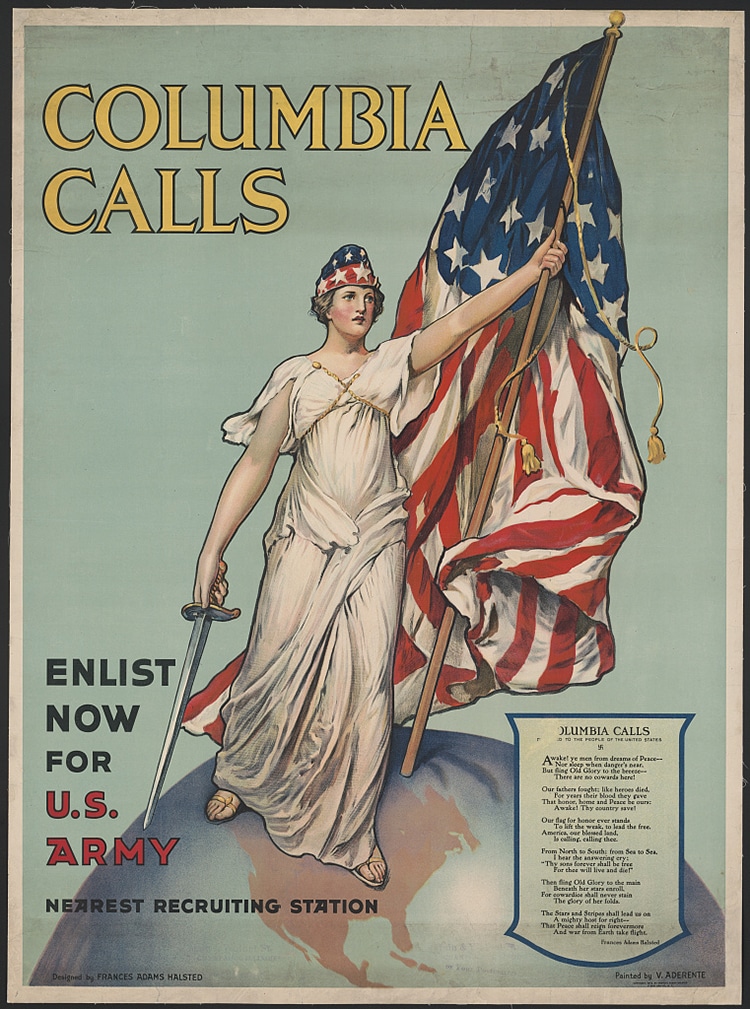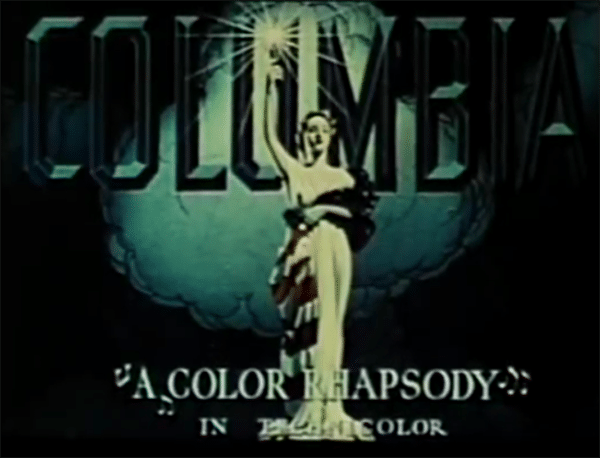While dramatic music sounds, a torch-bearing woman dressed like a Roman goddess appears on screen against heavenly clouds. Bold text behind her announces the name “Columbia.” This familiar tableau has appeared millions of times in theaters and living rooms around the world. This iconic logo of the storied Columbia Pictures studio helped define the 20th-century American film industry. But do you know its origins? The recognizable modern logo—adopted in the 1990s—originated as a stunning reference image by New Orleans-based photographer Kathy Anderson.
The idea of Columbia is an old one steeped in American history. In the 18th century, the term began to refer to America and eventually took on an anthropomorphic nature in literary works (such as the poetry of Phyllis Wheatley). Female goddess-like figures have long been symbolic of the state, such as Britannia in England and even Minerva (Goddess of War and Law) in Ancient Rome. Often posed with the flag draped around her, Columbia came to be associated with American strength and power at home and abroad. She is related to, yet usually distinct from, Lady Liberty.

“Columbia Calls—Enlist Now for U.S. Army,” an enlistment poster by Vincent Aderente, 1916. (Photo: Wikimedia Commons, Public domain)
Adopted as the Columbia Pictures’ namesake and logo in 1924, the company sketched their new heroine with a torch raised high like Lady Liberty. Her classical clothing was adorned with American flag drapery for a mid-century update. Her torch is depicted as casting bright rays of light. By the 1990s, the company was in search of a more modern logo, for which they turned to painter Michael Deas. Deas’ oil masterpieces have adorned the cover of TIME magazine, U.S. postage stamps, and bestselling books. Like many painters, he often used reference photos to craft the perfect image.
For the Columbia Pictures’ logo, Deas turned to his friend, photographer Kathy Anderson. Anderson worked at the New Orleans paper The Times-Picayune, where she employed her talents in portrait and documentary photography. Using a softbox and strobe lights, Anderson created the gentle sunrise light the painter envisioned. She also enlisted a model—her coworker Jenny Joseph, who had never modeled before. Deas brought a variety of classical and patriotic props, and the team set to work creating a magical image in the middle of Anderson’s dining room.
In front of a gray background, Joseph held a candle-shaped lamp aloft while draped in a Grecian ensemble. Anderson first shot instant Polaroids as proofs before beginning the roll of medium format color Kodak film. With her Hasselblad, Anderson captured a series of stunning images in different poses. One with the torch aloft and Joseph’s chin defiantly lifted eventually became the iconic logo, translated by Deas into a heavenly painted scene. However, Anderson told PetaPixel, “I shot one frame of her seated, which may be my favorite image from the shoot. But after chatting for a minute, she confided that she was pregnant. After congratulating her, we resumed shooting, but I was worried about her standing on the box.”
The home shoot which produced the iconic reference image and subsequent oil painting is one moment in two storied artistic careers. Anderson later won a Pulitzer Prize as part of The Times-Picayune team for their coverage of Hurricane Katrina. Deas has continued to paint iconic Americans, including a portrait of Benjamin Franklin for a TIME cover. Millions of people have seen their iconic Columbia Pictures image, but the story behind the image has remained largely unknown. It is an example of how passionate, artistic collaborations exist behind the many ubiquitous motifs in American visual culture.
Columbia Pictures’ iconic logo of a woman holding a torch aloft is a painting by Michael Deas, based on a stunning reference photo by photographer Kathy Anderson.

An older example of Columbia Picture’s logo, used 1936-76. (Photo: Wikimedia Commons, Public domain)
Over decades of experience, Anderson has produced iconic images from that of the “torch lady” to documentary shots of the devastation of Hurricane Katrina.
View this post on Instagram
Kathy Anderson: Website | Instagram | Facebook
Michael Deas: Website
h/t: [PetaPixel]
Related Articles:
Close Encounters With Sharks Win 2022 Underwater Photographer of the Year Contest
Photographer Captures Beauty and Power of Tornado Vortexes
Photographer Explores Tbilisi’s Mysterious Underground Soviet-Era City
Stunning Portraits Pays Homage to First Black Woman Millionaire With Decades of Black Hair Trends
